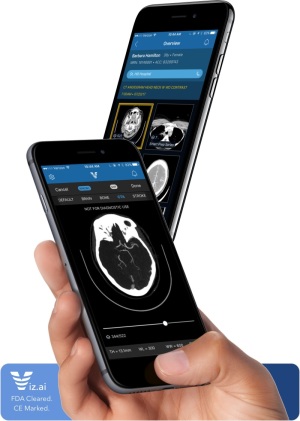by
John R. Fischer, Senior Reporter | February 16, 2018

The Viz.ai LVO Stroke Platform notifies
specialists before radiologists to intervene
early in cases of suspected
LVO strokes
A new AI-equipped software solution for notifying and ensuring earlier intervention in cases of stroke will soon be available to U.S. providers.
The FDA has granted De Novo clearance for the marketing of the Viz.ai LVO Stroke Platform, a computer-aided triage and notification platform designed to detect and alert specialists to potential large vessel occlusion (LVO) strokes during CTA scans, enabling earlier intervention and faster initiation of treatment.
“Strokes can cause serious and irreversible damage to patients. The software device could benefit patients by notifying a specialist earlier, thereby decreasing the time of treatment," Robert Ochs, acting deputy director for radiological health, Office of In Vitro Diagnostics and Radiological Health in the FDA’s Center for Devices and Radiological Health, said in a statement. "Faster treatment may lessen the extent or progression of a stroke.”



Ad Statistics
Times Displayed: 172944
Times Visited: 3140 For those who need to move fast and expand clinical capabilities -- and would love new equipment -- the uCT 550 Advance offers a new fully configured 80-slice CT in up to 2 weeks with routine maintenance and parts and Software Upgrades for Life™ included.
The system connects to a CT scanner and utilizes an AI algorithm to identify suspected LVO strokes.
It then alerts neurovascular specialists by sending radiological images directly to their smartphone or tablet, the delivery of which takes place at the same time as the first-line provider is reviewing images, enabling the specialist to intervene before being notified by a radiologist, though images must still be reviewed on a clinical workstation.
A clinical study comparing the solution to the performance of two trained neuroradiologists in assessing 300 CT images for the detection of large vessel brain blockages found that it obtained an AUC of 0.91, and identified and alerted specialists with 90 percent sensitivity and specificity to the presence of LVOs, with a median scan to notification time of under six minutes.
Automatic notifications in more than 95 percent of cases demonstrated faster alerts to specialists, with between 6 and 206 minutes saved, an average of 52 minutes.
The device, however, is meant to assist radiologists in making diagnoses faster, not replace them.
"The radiologist remains an integral part of the stroke workflow," Dr. Chris Mansi, neurosurgeon and chief executive officer of Viz.ai, told HCB News. "While the software will triage positive scans for faster workflow, the radiologist expertise is needed to make the radiological diagnosis and advise the stroke neurologist on clinical decisions. The radiologist is also needed to interpret the whole scan."
Assisting in the sale of the solution as well as other Viz.ai products is Conrad Yiu, who carries 11 years of experience in the neurovascular field, and was just last month hired as the company's chief commercial officer.
“I am excited about the opportunity that Viz.ai brings to acute stroke care and the potential for addressing all time-sensitive diseases,” said Yiu in a statement. “With so many therapies available for patients, the integration of deep learning, communication and workflow optimization will be critical factors to driving patient access and improving outcomes. The Viz.ai platform can help drive value-based health care initiatives around time-sensitive therapies.”
The Viz.ai LVO Stroke Platform is intended for use by neurovascular specialists, including vascular neurologists, neuro-interventional specialists or other similarly-trained professionals.
The solution is limited to imaging data analysis and is not meant to replace full patient evaluations or be used alone for making or confirming diagnoses.
The platform was CE marked in January.

